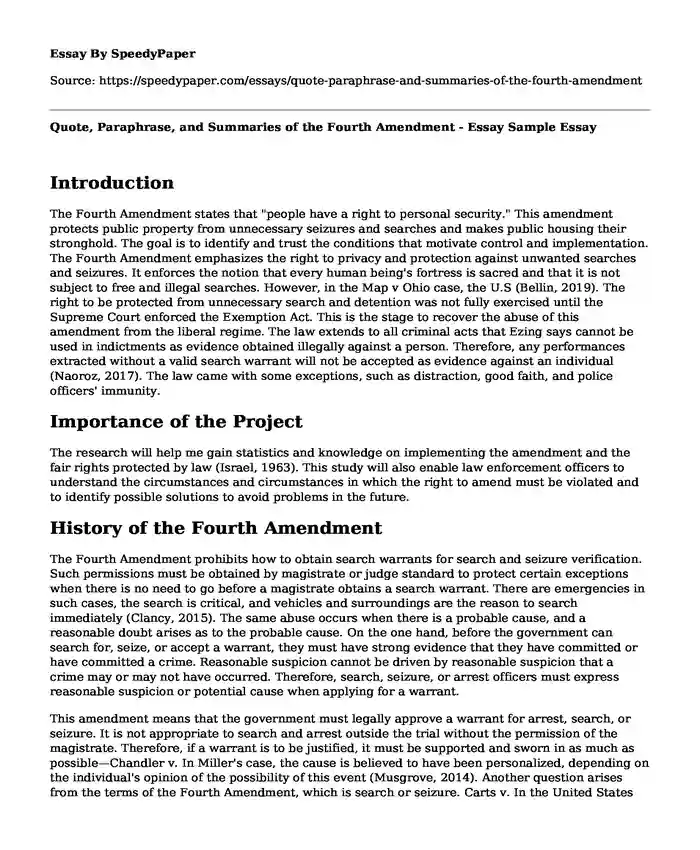
| Type of paper: | Essay |
| Categories: | Government Constitution |
| Pages: | 3 |
| Wordcount: | 741 words |
Introduction
The Fourth Amendment states that "people have a right to personal security." This amendment protects public property from unnecessary seizures and searches and makes public housing their stronghold. The goal is to identify and trust the conditions that motivate control and implementation. The Fourth Amendment emphasizes the right to privacy and protection against unwanted searches and seizures. It enforces the notion that every human being's fortress is sacred and that it is not subject to free and illegal searches. However, in the Map v Ohio case, the U.S (Bellin, 2019). The right to be protected from unnecessary search and detention was not fully exercised until the Supreme Court enforced the Exemption Act. This is the stage to recover the abuse of this amendment from the liberal regime. The law extends to all criminal acts that Ezing says cannot be used in indictments as evidence obtained illegally against a person. Therefore, any performances extracted without a valid search warrant will not be accepted as evidence against an individual (Naoroz, 2017). The law came with some exceptions, such as distraction, good faith, and police officers' immunity.
Importance of the Project
The research will help me gain statistics and knowledge on implementing the amendment and the fair rights protected by law (Israel, 1963). This study will also enable law enforcement officers to understand the circumstances and circumstances in which the right to amend must be violated and to identify possible solutions to avoid problems in the future.
History of the Fourth Amendment
The Fourth Amendment prohibits how to obtain search warrants for search and seizure verification. Such permissions must be obtained by magistrate or judge standard to protect certain exceptions when there is no need to go before a magistrate obtains a search warrant. There are emergencies in such cases, the search is critical, and vehicles and surroundings are the reason to search immediately (Clancy, 2015). The same abuse occurs when there is a probable cause, and a reasonable doubt arises as to the probable cause. On the one hand, before the government can search for, seize, or accept a warrant, they must have strong evidence that they have committed or have committed a crime. Reasonable suspicion cannot be driven by reasonable suspicion that a crime may or may not have occurred. Therefore, search, seizure, or arrest officers must express reasonable suspicion or potential cause when applying for a warrant.
This amendment means that the government must legally approve a warrant for arrest, search, or seizure. It is not appropriate to search and arrest outside the trial without the permission of the magistrate. Therefore, if a warrant is to be justified, it must be supported and sworn in as much as possible—Chandler v. In Miller's case, the cause is believed to have been personalized, depending on the individual's opinion of the possibility of this event (Musgrove, 2014). Another question arises from the terms of the Fourth Amendment, which is search or seizure. Carts v. In the United States case, when the government wiretaps a conversation through secret microphones, a person who engages in activities such as telephone communication in the hope of privacy is infiltrated (Solove, 2010). So the function of wiretapping involves a search—Carpenter v. The recent decision by the United States to make it mandatory to obtain a government warrant before receiving CSLI recordings limits the Examinations Act.
Conclusion
As technological evolution and threats to society increase, there is uncertainty in raising the Fourth Amendment standards. For example, people get robbed before boarding a plane or going to the bank. Avoid weapons and other harmful substances for several reasons. However, there is no reason to do this only as a precaution.
References
Bellin, Jeffrey (2019). "Fourth Amendment Textualism." SSRN Electronic Journal. Elsevier BV, doi:10.2139/ssrn.3309688.
Brennan-Marquez, Kiel Robert (2015). "Fourth Amendment Fiduciaries." SSRN Electronic Journal, Elsevier BV, doi:10.2139/ssrn.2572052.
Clancy, Thomas K. (2015). "Fourth Amendment Satisfaction -- The 'Reasonableness' Of Digital Searches." SSRN Electronic Journal. Elsevier BV, doi:10.2139/ssrn.2613627.
Israel, Jerold H (1963). "Gideon V. Wainwright. The "Art" Of Overruling." The Supreme Court Review, vol 1963, pp. 211-272. University Of Chicago Press, doi:10.1086/scr.1963.3108734.
Kerr, O. S. (2012). The mosaic theory of the Fourth Amendment. Mich. L. Rev., 111, 311.
Musgrove, Shalyn. (2014) "The Fourth Amendment: Policing The Police And The Warrantless Search." SSRN Electronic Journal. Elsevier BV, doi:10.2139/ssrn.2407214.
Naoroz, C., n.d. (2017). Police Officer Perceptions Of Organizational Justice And Body-Worn Cameras.
Solove, D. J. (2010). Fourth amendment pragmatism. BCL, Rev., 51, 1511.
Cite this page
Quote, Paraphrase, and Summaries of the Fourth Amendment - Essay Sample. (2023, Dec 13). Retrieved from https://speedypaper.com/essays/quote-paraphrase-and-summaries-of-the-fourth-amendment
Request Removal
If you are the original author of this essay and no longer wish to have it published on the SpeedyPaper website, please click below to request its removal:
- Information technology research paper
- Free Essay on Healthcare Issues in Women Veterans
- Role of Drones in Shaping the Future of War - Research Paper
- Essay Example. The Concentration of Wealth in Jakarta Indonesia
- Followership and Servant Leadership in the Army - Free Paper Example
- American Constitutional Law - Paper Example
- Paper Example on Prisoners Dilemma
Popular categories




